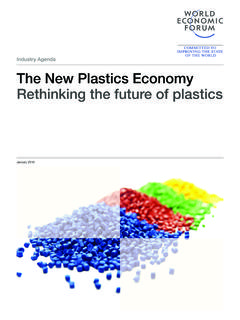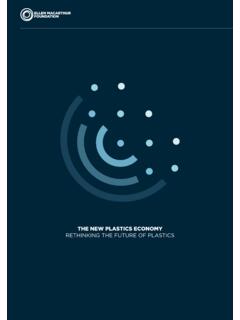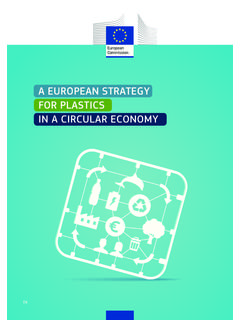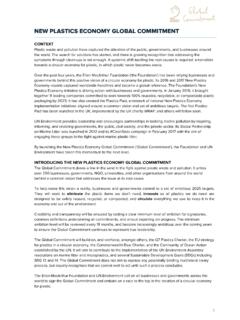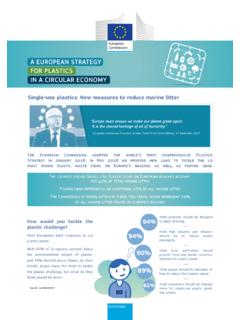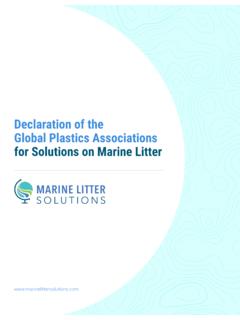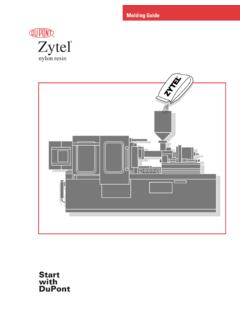Transcription of Bioplastics - furthering efficient waste management
1 FACT SHEETE uropean BioplasticsRecycling and recovery options for bioplasticsBioplastics - furthering efficient waste managementWaste management in EuropeEfficient waste management is key to the European Commis-sion s flagship policy of a resource efficient Europe and its vi-sion of a circular bioeconomy. Yet, today, the waste manage-ment infrastructure still varies immensely within the the European Union waste Framework Directive 2008 a waste hierarchy1 has been defined in five steps according to their desirability: 1) prevention; 2) preparation for re-use; 3) recycling; 4) other recovery options, such as energy recovery; and 5) disposal. The goal is to conserve resources as best increasing recycling targets and a gradual phase-out of landfilling, Europe is on the road to fulfilling its efficiency tar-gets and realising a true closed loop economy.
2 Bioplastics can contribute to this development on different levels. Based on renewable feedstock, Bioplastics spare fossil re-sources and offer great potential for reducing greenhouse emissions. When it comes to waste management options, it is important to note that Bioplastics include a whole family of different materials. They can be treated in various established recycling and recovery streams, and offer additional options such as organic recycling (composting). Bioplastics can further efficient waste stream management in the : EU waste hierarchy1 Classification of waste management options according to the order of their environmental Bioplastics Marienstr. 19/20 10117 BerlinEuropean Bioplastics Marienstr. 19/20, 10117 Berlin+ 48 23 50+ 48 23 phonefaxe-mailwebVR 19997 Nz, Amtsgericht Charlottenburg, USt-IdNr.
3 DE235874231 HypoVereinsbank Rosenheim, BLZ 711 200 77, Konto 6356800, IBAN DE26 7112 0077 0006 3568 00, BIC/SWIFT HYVEDEMM448 waste management options and benefits of bioplasticsAs with conventional plastics , the manner in which bioplas-tics waste is recovered depends on the type of the product, the Bioplastics material used, as well as the volumes and recovery systems and reductionThis step of the waste hierarchy requires the use of manu-facturing processes and materials that minimise resource use and maximise the functional performance of the prod-uct. plastics have consistently proved their suitability, with products becoming increasingly thinner, lighter, and strong-er. The rules of competition as well as the economic and ecological demands of the market also lead to Bioplastics increasing their performance and resource efficiency.
4 The amount of products already available on the market and the high growth rates testify to what Bioplastics have is already a large number of plastic products that can be reused multiple times. PET bottles can be recirculated in recycling systems after cleaning, and the same is true for bio-based PET. Carrier bags made from bio-based PE, PLA, or starch materials can be reused many times before the ma-terial wears out. Bioplastics offer numerous opportunities for creating reusable recyclingExamples of easily recyclable plastic products are large sur-face films ( carrier bags), large hollow containers ( bottles), or construction materials ( window frames). The recyclability of plastic products depends on the product design, material composition, and the cost effectiveness of the process.
5 The task is simpler for products, which are not made from complex material blends and which can easily be seperated into recyclable new bio-based versions of PE, PET or (upcoming) PP are chemically and physically identical to their widely used fossil-based counterparts and, thus, can easily be disposed of in established recycling streams. The post-consumer recycling of other Bioplastics for which no separate stream yet exists will be feasible as soon as the commercial volumes and sales increased sufficiently enough to cover the investments required. New separate streams Graph: Post-consumer waste collection options for bioplasticsBioplastics - furthering efficient waste management ( for PLA) will be introduced in the short to medium term. Numerous research projects and tests, for PLA, are currently underway in Germany, Belgium, and the recycling/compostingUsing biodegradable and compostable plastic products such as (biowaste) bags, packaging, or cutlery can increase the options for the end-of-life treatment of those products.
6 In addition to recovering energy and mechanical recycling, industrial composting (organic recovery/organic recycling) becomes a waste management is a clear benefit when plastic items are mixed with bio- waste . Under these conditions, mechanical recycling is not feasible for neither the plastics nor the biowaste. The use of compostable plastics makes the mixed waste suitable for or-ganic recycling, enabling the shift from recovery to recycling (a treatment option which ranks higher on the waste hier-archy). This way, biowaste is diverted from other recycling streams or from landfill and separate collection facilitated resulting in the creation of more valuable compost. In order to be suitable for organic recycling, products and materials need to meet the strict criteria of the European norm EN 13432 on industrial compostability.
7 Following suc-Compostable flexible films in post-consumer recycling streamsCompostable plastics are designed for organic recycling and should be collected accordingly. For this pur-pose, they are marked with the Seedling label. In the event that compostable flexib-le films end up in recycling streams, the prevalent sorting technologies are able to sort them with little residual waste . Studies and field trials have demons-trated that, in the unlikely scenario of a small fraction of compostable flexible films ending up in the poly-ethylene (PE) recycle stream, it does not negatively impact the quality of the recycling stream at all. Remaining amounts are similar or even easier to handle than other residual wastes in the PE stream such as polystyrene or certification, these products and materials are per-mitted to be advertised and labelled as compostable.
8 The Seedling label is a well-known mark for products conforming to EN 13432. Feedstock recoveryWhenever mechanical recycling experiences technical diffi-culties or is not economically viable, feedstock recovery is the recommended alternative. These processes are consid-erably less sensitive to contaminants and can easily be op-erated with mixed materials. This includes the recovery of plastic waste as a secondary raw material in concrete or steel production, for instance. Bioplastics perform just like their fossil counterparts in this process and are therefore easily recovered in the same , bio-based and non-bio-based plastics togeth-er with municipal waste can be transformed into syngas through the process of gasification. The resulting syngas features a significant bio-based content that is determined by the input amount of bio-based plastics and organic waste .
9 Syngas can be used for either electricity generation, the production of fuel (synthetic petroleum), or the produc-tion of methanol and ethanol. In the latter case, it can sub-sequently be transformed into chemical feedstock such as olefins and acrylates with a high bio-based content for the polymerization of polyethylene, polypropylene, polyester and other recoveryIncineration of plastic waste to create heat and energy (elec-tricity) is one of the most frequent recovery option for plas-tic waste in Europe ( percent of plastic waste in 2014 was recovered through energy recovery processes).3 The high calorific value of plastics makes them an ideal replace-ment for coal and heating fuel. Whether they are bio-based or fossil-based makes no technical difference to the recovery process.
10 However, in the case of bio-based plastics , renew-able energy can be obtained from the biogenic carbon a significant is a hurdle to resource efficiency. Even though it is still one of the main disposal options in many countries in Europe, continual progress towards a phase-out can be observed. In 2014, around 31 percent of plastic waste went to landfills,4 7 percent less compared to 2012. European Bioplastics supports a European-wide ban on landfilling for Graph: Seedling logo for industrially compostable products conforming to EN 134322 Successfully operating plants for the transformation of syngas with a certain bio-based content into methanol and ethanol already exist in Canada (ENERKEM) and the United States (INEOS BIO). Commercial technology is also available to transform the resulting alcohols into chemical feedstock such as ethylene or Monoethyleneglycol used in the production of polyolefines and polyesters ( PET.)


